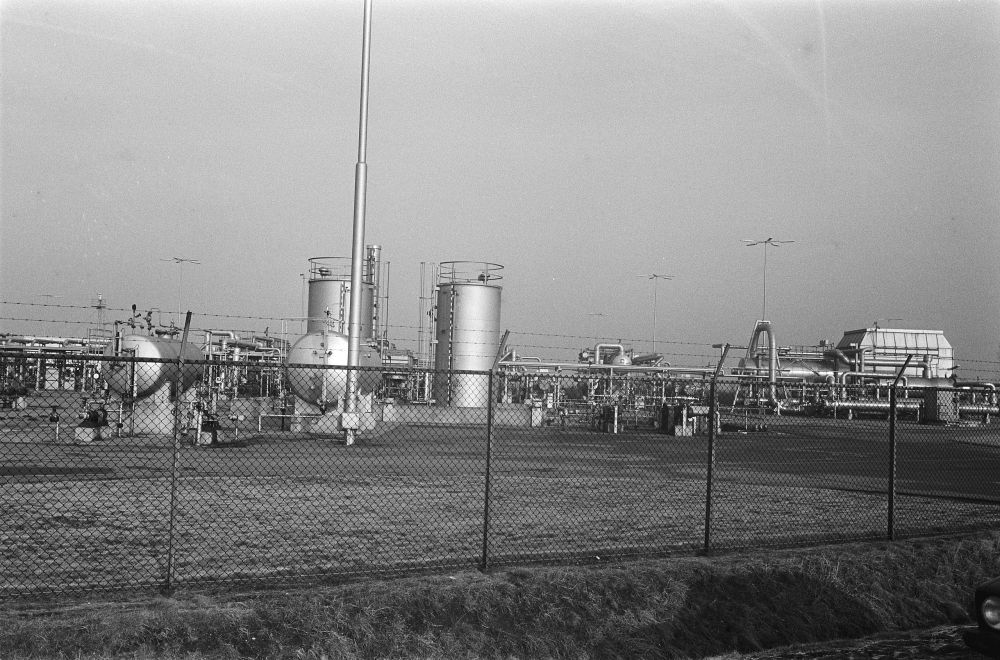THIS PAGE IS UNDER CONSTRUCTION
Searching for gas
Gas is often found in oil fields. It’s usually much older than the oil. Gas comes from the remains of plants that were decomposed into coal and natural gas (CH4) at great depth and temperatures above 150°. Like oil, natural gas can only be extracted if it’s trapped underneath an impermeable layer of rock. For example a layer of salt left over from evaporated seawater.
Hitting the jackpot at Slochteren
In 1959 the Dutch oil company NAM did some test drilling near the village of Slochteren in Groningen. They found a huge bubble of natural gas, trapped under a dome of salt. It transformed the Netherlands’ energy resources overnight, because Slochteren is one of the largest natural gas fields in the world. NAM produces 50 billion cubic metres of gas a year. Half of this still comes from the Groningen field. The rest comes from small fields elsewhere in the country and gas extraction at sea.
Forgotten lagoons
The oil and gas we use today have a very long history, being formed hundreds of millions of years ago in shallow coastal waters. Plankton, dead sea creatures and plants sank to the bottom, where they decomposed in water with very low levels of oxygen. Sand and clay covered the thick layer of remains. Over millions of years, they were crushed together.
No more oil?
Fossil fuels like coal, oil and gas are cheap widely available. It’s hardly surprising that such fuels account for 80% of the world’s total energy consumption. Nevertheless, this will have to change soon, because fossil fuel reserves will probably run short this century.
Climate change
The climate is noticeably changing, in part as a result of the use of fossil fuels. In the last century, the temperature has gone up by more than half a degree. It is expected to rise between two and six degrees over the next century.
Using natural gas isn’t really sustainable. But it does produce less carbon dioxide (CO2) than any other fossil fuel. Too much carbon dioxide in the atmosphere creates climate change. Oil produces 50% more CO2 and coal as much as 90%. That’s why the government has opted for natural gas as a bridge towards ‘sustainable gas’ in future. Hydrogen gas or bio-gas will then be mixed with natural gas to add ‘sustainability’.
Energy from gas and coal
Electricity can be generated by burning gas and coal. Fossil fuels such as gas and coal account for 90% of the electricity generated in the Netherlands. Of the 28 power stations burning fossil fuels (2004), 22 burn natural gas. The other six burn coal, often combined with wood chips. Such power stations have a performance of just under 60 %. This means that around 60 % of the heat is converted into electricity.
Olie
Olie ontstaat diep in de aarde. Meer en meer materiaal hoopt zich op en de organische laag van dode planten en dieren versteent op kilometers diepte onder hoge druk tot zwarte leisteen. De temperatuur loopt op tot rond de 100 graden Celsius. Onder hoge temperatuur en druk vallen de moleculen uiteen, ze worden 'gekraakt', tot kortere ketens, bestaand uit koolstof en waterstof. Het mengsel dat zo ontstaat is ruwe aardolie. Hoge druk perst aardolie langzaam omhoog door kleine barstjes in de steenlaag. Als de olie gevangen wordt onder een ondoordringbare zout- of leisteenlaag, spreken geologen van een olieval. Daar is mogelijk olie en aardgas te winnen.
Die olie moet worden opgeboord. Het boren gebeurt met een boorkop aan het uiteinde van een lange stalen pijp. De kop graaft zichzelf met draaiende beitels de grond in. Boven de boorput komt een boortoren die nodig is om de stalen pijp, de boorstang, telkens te verlengen met nieuwe pijpen.
De inhoud van een olievat (159 liter) is nog steeds de eenheidsmaat in de oliewereld. De verwachting is dat het wereldverbruik tot 2024 wel meer dan 100 miljoen vaten per dag zal zijn. Dat zijn ruim zesduizend zwembaden vol. Elke dag weer.

Aardgaswinning in Slochteren. Fotograaf: Evers, Joost / Anefo - Publiek domein
Nederland, aardgasland
Bij een olieveld wordt ook vaak gas gevonden. Meestal is gas veel langer geleden gevormd dan olie. Op grote diepte en bij temperaturen hoger dan 150 graden Celsius zijn de plantenresten gekraakt tot steenkool (C) en aardgas (CH4). Net als aardolie is aardgas alleen te winnen als het onder een aardlaag gevangen blijft. Bijvoorbeeld een zoutlaag als overblijfsel van een verdampte zee.
Het geluk van Slochteren
In 1959 deed de Nederlandse Aardolie Maatschappij (NAM) een proefboring in de buurt van het Groningse plaatsje Slochteren. Ze vonden een heleboel gas, gevangen onder een zoutkoepel. Dit maakte Nederland tot aardgasland. Het Groningen-veld is namelijk één van de grootste aardgasvelden ter wereld. De NAM produceerde in 2022 8,4 miljard kubieke meter aardgas, het grootste deel nog steeds in Groningen. De rest kwam uit kleine velden op het land en uit gaswinning op zee.
Klik door naar...

